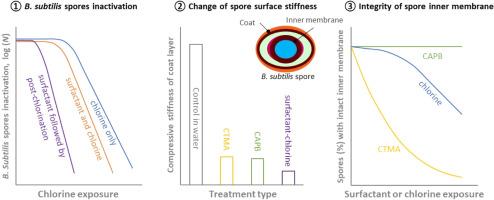Effect of surfactants on inactivation of Bacillus subtilis spores by chlorine
IF 12.4
1区 环境科学与生态学
Q1 ENGINEERING, ENVIRONMENTAL
引用次数: 0
Abstract
Bacterial spores pose significant risks to human health, yet the inactivation of spores is challenging due to their unique structures and chemical compositions. This study investigated the synergistic effect between surfactants and chlorine on the inactivation kinetics of Bacillus subtilis spores. Two surfactants, cocamidopropyl betaine (CAPB) and cetyltrimethylammonium chloride (CTMA) were selected to investigate chlorine disinfection in absence and presence of surfactants. The concurrent presence of both chlorine and surfactant resulted in a moderate reduction in the lag-phases for spore inactivation and negligible increase in the second-order inactivation rate constants. In contrast, when the spores were pre-exposed to surfactants, the lag-phases decreased by about 50 % for both CAPB and CTMA, and the second-order inactivation rate constants during post-chlorination remained constant for CAPB but increased by a factor of 2.3 for CTMA, compared to the control group with phosphate buffer. This synergistic effect became more pronounced with longer surfactant pre-exposure times, reaching its maximum at 3–6 h. The observed synergistic effect suggests that surfactants can potentially enhance the permeability of the coat which is the outmost layer of B. subtilis spores and a primary barrier for chemical disinfectants. Tracing a group of B. subtilis spores sequentially treated with surfactant and chlorine by atomic force microscopy, a significant decrease in compressive stiffness of the spores was observed due to exposure to surfactants, indicating alterations in the coat by surfactants. The trend in reducing compressive stiffness aligned well with the decrease of lag-phases in inactivation kinetics. Furthermore, CTMA was found to inactivate B. subtilis spores through mechanisms different from chlorine. Chlorine primarily inactivated B. subtilis spores before damaging the inner membrane of the spores which plays a crucial role in protecting the genetic material stored in the core of the spores. In comparison, CTMA damaged 22 % of the inner membrane for an inactivation efficiency of 99 %. A synergistic effect in damaging the inner membrane was observed when applying CTMA and chlorine simultaneously instead of sequentially.


表面活性剂对氯灭活枯草芽孢杆菌孢子的影响
细菌孢子对人类健康构成重大威胁,但由于其独特的结构和化学成分,使孢子灭活具有挑战性。研究了表面活性剂和氯对枯草芽孢杆菌孢子灭活动力学的协同作用。以椰油酰胺丙基甜菜碱(CAPB)和十六烷基三甲基氯化铵(CTMA)两种表面活性剂为研究对象,研究了无表面活性剂和有表面活性剂情况下的氯消毒效果。氯和表面活性剂的同时存在导致孢子失活的滞后期适度减少,二级失活速率常数的增加可以忽略不计。相比之下,当孢子预先暴露于表面活性剂时,CAPB和CTMA的滞后期都减少了约50%,CAPB在氯化后的二级失活速率常数保持不变,而CTMA在氯化后的二级失活速率常数比使用磷酸盐缓冲液的对照组增加了2.3倍。随着表面活性剂预暴露时间的延长,这种协同效应变得更加明显,在3-6 h时达到最大。观察到的协同效应表明,表面活性剂可以潜在地增强枯草芽孢杆菌孢子最外层的透性,这是化学消毒剂的主要屏障。原子力显微镜对一组枯草芽孢杆菌孢子进行了表面活性剂和氯的连续处理,观察到由于表面活性剂的暴露,孢子的压缩刚度显著降低,这表明表面活性剂改变了孢子的外壳。压缩刚度降低的趋势与失活动力学中滞后相的减少是一致的。此外,CTMA灭活枯草芽孢杆菌的机制不同于氯。氯首先灭活枯草芽孢杆菌孢子,然后破坏孢子的内膜,这对保护储存在孢子核心的遗传物质起着至关重要的作用。相比之下,CTMA破坏了22%的内膜,失活效率为99%。当CTMA和氯同时施用而不是依次施用时,观察到对内膜的破坏具有协同效应。
本文章由计算机程序翻译,如有差异,请以英文原文为准。
求助全文
约1分钟内获得全文
求助全文
来源期刊

Water Research
环境科学-工程:环境
CiteScore
20.80
自引率
9.40%
发文量
1307
审稿时长
38 days
期刊介绍:
Water Research, along with its open access companion journal Water Research X, serves as a platform for publishing original research papers covering various aspects of the science and technology related to the anthropogenic water cycle, water quality, and its management worldwide. The audience targeted by the journal comprises biologists, chemical engineers, chemists, civil engineers, environmental engineers, limnologists, and microbiologists. The scope of the journal include:
•Treatment processes for water and wastewaters (municipal, agricultural, industrial, and on-site treatment), including resource recovery and residuals management;
•Urban hydrology including sewer systems, stormwater management, and green infrastructure;
•Drinking water treatment and distribution;
•Potable and non-potable water reuse;
•Sanitation, public health, and risk assessment;
•Anaerobic digestion, solid and hazardous waste management, including source characterization and the effects and control of leachates and gaseous emissions;
•Contaminants (chemical, microbial, anthropogenic particles such as nanoparticles or microplastics) and related water quality sensing, monitoring, fate, and assessment;
•Anthropogenic impacts on inland, tidal, coastal and urban waters, focusing on surface and ground waters, and point and non-point sources of pollution;
•Environmental restoration, linked to surface water, groundwater and groundwater remediation;
•Analysis of the interfaces between sediments and water, and between water and atmosphere, focusing specifically on anthropogenic impacts;
•Mathematical modelling, systems analysis, machine learning, and beneficial use of big data related to the anthropogenic water cycle;
•Socio-economic, policy, and regulations studies.
 求助内容:
求助内容: 应助结果提醒方式:
应助结果提醒方式:


